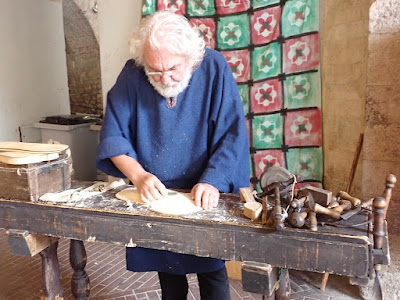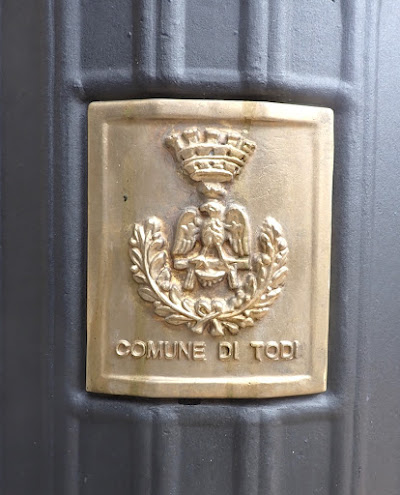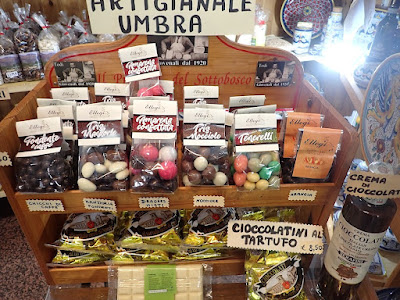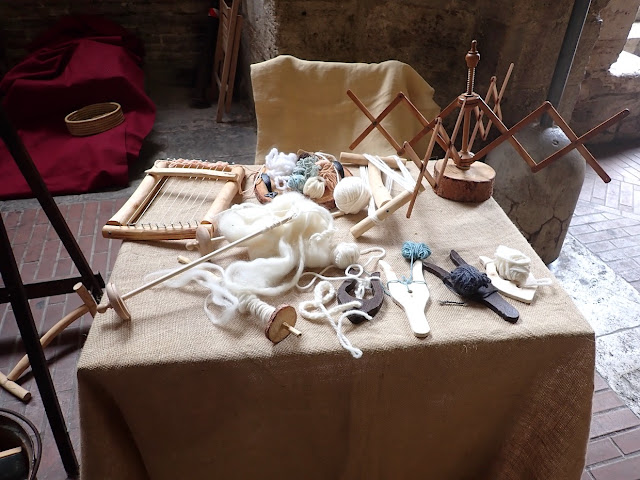13 October 2022 - Todi - our last full day at La Romita!
 Todi is another one of my favorite towns in Italy, and our visit there just reinforced what a wonderful little place it is!
Todi is another one of my favorite towns in Italy, and our visit there just reinforced what a wonderful little place it is!
First, we stopped at the little church outside the town itself, Santa Maria della Consolazione. Yes,  the church of Saint Mary of the Consolation. Quite a name. This is probably my favorite church that I've visited in Italy - it was built in the 16th century, and seems to embody all the Renaissance ideals of the rebirth of scientific and mathematical thought incorporated into religious architecture. Really, the shape is like a square
the church of Saint Mary of the Consolation. Quite a name. This is probably my favorite church that I've visited in Italy - it was built in the 16th century, and seems to embody all the Renaissance ideals of the rebirth of scientific and mathematical thought incorporated into religious architecture. Really, the shape is like a square  cross, but inside the clean arches soar into light and spirituality, lifting souls to the heavens - metaphorically, anyway. It's just a lovely little church, very different from the ornate cathedrals that I find overpowering. Absolutely worth a visit to this church.
cross, but inside the clean arches soar into light and spirituality, lifting souls to the heavens - metaphorically, anyway. It's just a lovely little church, very different from the ornate cathedrals that I find overpowering. Absolutely worth a visit to this church.
 Then we headed in to the town of Todi, which was having their own Medieval festival. We had been told there would be some kind of art or artisan show or exhibit, Edmund wasn't quite sure exactly what it was.
Then we headed in to the town of Todi, which was having their own Medieval festival. We had been told there would be some kind of art or artisan show or exhibit, Edmund wasn't quite sure exactly what it was.
It turned out to be quite interesting!
Well, first - the main square or piazza had sort of barricades around it, not so much to keep traffic out as to hold a variety of shields to decorate the square. They looked like they might be the shields knights would use in battle, though perhaps smaller than adults might use. But colorful and  cheerful on this rather wet morning.
cheerful on this rather wet morning.
There were stacks of more shields against a wall, and shields hanging along a staircase going up to some government-looking building.
One of the largest buildings in the main square had long banners, more like long slender flags, hanging from the top floor windows. Between the banners and the shields, things definitely were decorated for some  kind of event.
kind of event.
We saw that the ground floor area of this building was actually open, a series of arches leading into a large covered area. And this is where the arts and crafts part of the event was happening!
 Basically, a group of artists and artisans had put together an exhibit of traditional arts that date back to the Medieval period. Various experts in each art (or craft) were dressed in Medieval clothing, demonstrating their art. One woman was spinning wool, and we talked with her about natural dyes and what plant
Basically, a group of artists and artisans had put together an exhibit of traditional arts that date back to the Medieval period. Various experts in each art (or craft) were dressed in Medieval clothing, demonstrating their art. One woman was spinning wool, and we talked with her about natural dyes and what plant  is used for what color, mordants (chemicals that set natural dyes), the sheep they raise, and so on. She had yarn and fabric available for purchase, and it was tempting, especially some of the gorgeous indigo colors!
is used for what color, mordants (chemicals that set natural dyes), the sheep they raise, and so on. She had yarn and fabric available for purchase, and it was tempting, especially some of the gorgeous indigo colors!
 A man was demonstrating how to make handmade paper, lifting the pulpy mixture onto fabric screens, straining out the water, and setting the wet paper onto thick squares of wool felt to dry. He also was selling some of his thick paper, as well as small books he had made binding the papers together with leather covers. He also had a pre-Gutenberg sort of printing press, or at least I think it was a press.
A man was demonstrating how to make handmade paper, lifting the pulpy mixture onto fabric screens, straining out the water, and setting the wet paper onto thick squares of wool felt to dry. He also was selling some of his thick paper, as well as small books he had made binding the papers together with leather covers. He also had a pre-Gutenberg sort of printing press, or at least I think it was a press.
There was a luthier, a person who makes guitars,  lutes, violins, and other stringed instruments. He didn't speak much English, but we watched him sanding away to get the proper curve for the back on some instrument.
lutes, violins, and other stringed instruments. He didn't speak much English, but we watched him sanding away to get the proper curve for the back on some instrument.
I think my favorite, though, was the engineer. Now, I have to start by saying that I love period re-enactments. I'm perfectly happy adopting a persona from a different time period and just going with it. Not that I know a lot about history, but I know a lot about art from different time periods, so I just mentally put myself into a painting and go from there.  Too much imagination.
Too much imagination.
So I saw a man with grey hair and a beard, with a slouchy velvet cap and rather ornate velvet clothing, and sizeable decorations on his clothing. He was standing near a variety of wood models that had ladders, platforms, and such.  Hmmmm. I figured if he was from the 14th or 15th century, and he's inventing wooden machines, wearing the velvet beret, well of course, I knew exactly who he was!
Hmmmm. I figured if he was from the 14th or 15th century, and he's inventing wooden machines, wearing the velvet beret, well of course, I knew exactly who he was!
Yes, I walked over and said, "buon giorno, Signor da Vinci!" Ah, no, he shook  his head and said "no, no, sono un ingegnere." It's easier to hear than to spell, because I could definitely understand no, he's not Leonardo da Vinci, he's an engineer. Sigh. I had such high hopes for him being da Vinci!
his head and said "no, no, sono un ingegnere." It's easier to hear than to spell, because I could definitely understand no, he's not Leonardo da Vinci, he's an engineer. Sigh. I had such high hopes for him being da Vinci!
But he did show me his models that included a  crane to lift building materials to the upper levels of buildings such as duomos and cathedrals. He also had extension ladders that used wood gears to extend the upper portion. There was a battering ram on a wagon (aptly named "Aries"), and a catapult. One thing was totally confusing and I never did understand his explanation since it was in Italian, and the machine itself wasn't obvious.
crane to lift building materials to the upper levels of buildings such as duomos and cathedrals. He also had extension ladders that used wood gears to extend the upper portion. There was a battering ram on a wagon (aptly named "Aries"), and a catapult. One thing was totally confusing and I never did understand his explanation since it was in Italian, and the machine itself wasn't obvious.
It all was interesting, even if we couldn't understand much of the explanations. Groups of students and  their teachers and chaperones came through and moved from exhibit to exhibit, watching demonstrations and listening to explanations. I tried not to get the kids in the photos, privacy and all, but at times the place was packed with the school groups. The only way I could get a photo of Leonardo was while he was surrounded by students. (None of the students thought the engineer was da Vinci.)
their teachers and chaperones came through and moved from exhibit to exhibit, watching demonstrations and listening to explanations. I tried not to get the kids in the photos, privacy and all, but at times the place was packed with the school groups. The only way I could get a photo of Leonardo was while he was surrounded by students. (None of the students thought the engineer was da Vinci.)
When it got too crowded, we found a coffee/pastry  place, and had our cappuccino and a bite. Waited out the crowd, and went back for more photos when things emptied out. (Yes, this is a mini fruit tart. Because fruit is healthy, right? How can anyone resist healthy and beautiful mini pastry?)
place, and had our cappuccino and a bite. Waited out the crowd, and went back for more photos when things emptied out. (Yes, this is a mini fruit tart. Because fruit is healthy, right? How can anyone resist healthy and beautiful mini pastry?)
Eventually, we had enough photos of all the engineering machines, wool, instruments, and paper, and we wandered on to explore other parts of Todi.
I found signs for the different neighborhoods, or rione. There are six rione in Todi, and we walked through four of them. I suspect the six shield designs we saw in the main piazza represent the six rione, though I can't say for certain, the designs on the signs aren't exact matches for the shield designs. But it does make sense.
We wandered in and out of shops, people buying final souvenirs and gifts. There were gorgeous ceramic table tops, jewelry, clothing, and more ceramics. Looked out over scenic overlooks, admired the views of the rest of town, and just enjoyed spending our last day exploring this lovely little city.
And then oh, the alimentari! The food store! All kinds of delightful foods made and packaged in Umbria, from pastas to truffles to olive oil to salumi, the general term for cold cuts and sausages. Chocolate, all kinds of chocolates! It all looked amazing, but we were packing that afternoon and I already knew how tightly packed my luggage had been when I arrived. So no shopping for me.
We had lunch at a wonderful restaurant overlooking the fields and plains below the hill on which Todi is built. It was green and grey in the October drizzle, but Italy is one of those places where even the rain looks good.
However, we all needed to pack up our artwork, art supplies, souvenirs, and get ready to leave the next day. Some people were flying out, others were spending time in Rome, and a few of us were planning to explore other parts of Italy. But we did need to get back to La Romita, and do that packing. So, all too soon, we headed out from Todi.
The funicular (or ascensore) that goes from the town down to the parking area was being repaired, and even though there was a shuttle van, most of us walked back down. There were views along the way looking back at town, interesting views of the valleys, pretty signs. Even carved borders in the old stone walls of the city!
Somewhere along the way I picked up a brochure about Todi's Medieval festival, though, and it sounded quite exciting! The events went on for about a week, and included parades, archery competitions, and the sbandieratori from San Gemini! (Kind of cool that we all knew exactly what that item was on the schedule, even when written in Italian!)
Richard and I have friends who have a house in Todi, though they were off travelling elsewhere in the world when I was in Italy. But I think some year, a visit to Todi for their Medieval festival might be in order. It was fun, and the rest of the week looked even more thrilling!
Besides, maybe next time that man will admit that yes, he IS Leonardo da Vinci!
Note: I've included a map at the very end, so you can see the region where we travelled to visit all these towns. The red star is Terni, where La Romita is located. The green stars indicate all the towns/cities we visited, as well as Villa Lante, the gardens, and La Cascata delle Marmore, the waterfall. Hope this puts things into context for you!






























che bello
ReplyDeleteHaven't been to Todi: and your blog makes me want to get there! So intriguing to see the machinery models used to lift construction materials high into the cathedral . . . I am sure da Vinci himself knew all about it!
ReplyDeleteWhat an incredible collection of craft work. Every time I marvel at the infrastructure behind modern day highways and high-rises, these methods were at the base of the mountain on which they were developed. Thank you again for sharing.
ReplyDelete